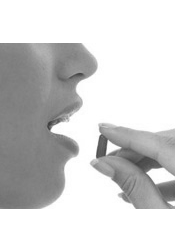Suprax® tablets
This product is manufactured by Sanofi-Aventis Canada Inc. using the ingredient cefixime.
This product is taken orally.

play
orally
Why is it prescribed?
Cefixime is used to treat infections caused by various bacteria. This material will be limited to the treatment of respiratory tract infections (e.g. sinusitis, bronchitis) and infections of the middle ear.
- Use exactly as prescribed. Store at room temperature.
- Suprax® tablets can be taken with food to lessen possible stomach upset.
- If you have been instructed to take one dose a day (e.g. every 24 hours), try to take it at the same time each day until finished. Failure to take the complete course can result in incomplete elimination of the bacteria which can lead to a relapse of the infection. The prescribed course generally lasts a few days longer than symptoms of the infection (e.g. fever). Treatment usually lasts 10 to 14 days. If you miss a dose, take it as soon as possible. If it is almost time for your next dose, do not take 2 doses at once (unless you have been instructed to do so). Contact your pharmacist if you are not sure what to do.
- Suprax® may produce an allergic reaction which can range in severity from a mild rash or itching to a life-threatening reaction. Contact your doctor or pharmacist if you experience rash, itching, fever, difficulty breathing, chest tightness or anything else that alarms you.
- If diarrhea occurs (severe or persistent), contact your doctor or pharmacist.
Alternatives
Other products that have the same ingredient as Suprax® tablets are •Auro-cefixime tablets •Suprax® suspension •
See other products used in the treatment of •middle ear infections •respiratory tract infections •sinus infections •sinusitis •
The usual dose for adults and children weighing over 50 kg is 400 mg once daily. In children, the usual dose is 8 mg per kg of body weight once daily or, in some cases, divided into two doses daily.
Cefixime is an antibiotic medication that kills various bacteria. It works by inhibiting the synthesis of one of the building blocks needed for the bacteria to make its cell wall. This results in a cell wall that is defective and more likely to rupture. The effectiveness of cefixime depends on factors such as dose, concentration in the blood as well as other body fluids and tissue, and the susceptibility of the bacteria. Cefixime does not kill all types of bacteria, but only those that have a sensitivity to this antibiotic. Infections caused by bacteria that are not sensitive to cefixime will not show improvement after taking this medication.
Along with its needed effects, cefixime may cause some unwanted or undesirable effects. Generally, cefixime is well tolerated and many people will not experience unwanted effects. The frequency and severity of these effects is dependant on many factors including dose, duration of therapy and individual susceptibility. Possible unwanted effects include:
- diarrhea
- nausea
- heartburn
- loose stools
- stomach ache
- headache
- dizziness
Uncommon:
- gas
- vomiting
- vaginal yeast infection
- genital itching
- allergic reaction (hives, itching, rash, difficulty breathing)
Rare:
- pseudomembranous colitis (inflammation of the colon caused by the overgrowth and toxin production of bacteria that are not killed by the antibiotic)
Taking the antibiotic repeatedly or for prolonged periods may result in bacterial or fungal overgrowth which can lead to a second infection. When this occurs, the cefixime may need to be stopped and another antibiotic prescribed to treat the new infection.
Diarrhea often develops while taking cefixime. This is sometimes caused by an overgrowth of bacteria in the gut that are not killed by the antibiotic. In severe cases this may be life threatening and would require treatment with other antibiotics. In mild cases, symptoms disappear shortly after the drug is discontinued.
There is some evidence to show that people who are allergic to penicillin may also be allergic to cefixime and vice versa. Be sure to inform your doctor and pharmacist of any antibiotic allergy or suspected allergy that you may have had in the past. Use is not recommended in the following situations:
allergy to cephalosporins (e.g. cephalexin)
Caution is recommended in the following situations:
- kidney disease
- allergy to penicillin
- stomach or intestinal disease (e.g. colitis)
- prolonged, repeated therapy
False positive direct Coombs' tests (test used in detecting a type of blood disorder) may be caused by cefixime. Cefixime may cause false urine test results for glucose.
Use in pregnancy: Considered compatible with pregnancy, although other medications in this family may be preferred. Consult your doctor or pharmacist before use.
Use while breastfeeding: Cefixime appears in breast-milk, but in small amounts. It is generally considered safe in breastfeeding, however, consult your doctor or pharmacist before use.
